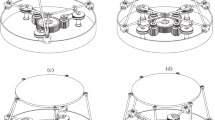Abstract
The pre-research on mobility analysis presented a unified-mobility formula and a methodology based on reciprocal screw theory by HUANG, which focused on classical and modern parallel mechanisms. However its range of application needs to further extend to general multi-loop spatial mechanism. This kind of mechanism is not only more complex in structure but also with strong motion coupling among loops, making the mobility analysis even more complicated, and the relevant research has long been ignored. It is focused on how to apply the new principle for general spatial mechanism to those various multi-loop spatial mechanisms, and some new meaningful knowledge is further found. Several typical examples of the general multi-loop spatial mechanisms with motion couple even strong motion couple are considered. These spatial mechanisms include different closing way: over-constraint appearing in rigid closure, in movable closure, and in dynamic closure as well; these examples also include two different new methods to solve this kind of issue: the way to recognize over-constraints by analyzing relative movement between two connected links and by constructing a virtual loop to recognize over-constraints. In addition, over-constraint determination tabulation is brought to analyze the motion couple. The researches above are all based upon the screw theory. All these multi-loop spatial mechanisms with different kinds of structures can completely be solved by following the directions and examples, and the new mobility theory based on the screw theory is also proved to be valid. This study not only enriches and develops the theory and makes the theory more universal, but also has a special meaning for innovation in mechanical engineering.
Similar content being viewed by others
References
XIE Cunxi, ZHENG Shixiong, LIN Yiqing. Design of spatial mechanism[M]. Shanghai: Shanghai Scientific & Technical Publishers, 1996. (in Chinese)
GOGU G. Mobility of mechanisms: a critical review[J]. Mechanism and Machine Theory, 2005, 40(9): 1068–1097.
KONG Xianwen, GOSSELIN C M. Mobility analysis of parallel mechanisms based on screw theory and the concept of equivalent serial kinematic chain[C]//Proceedings of the ASME Design Engineering Technical Conference, Long Beach, California, USA, September 24–28, 2005: 911–920.
RICO J M. Mobility of single loop linkages: a final word?[C]//Proc. of ASME Mechanisms Conf. 2007, DETC2007–34936.
YANG Tingli, LIU Anxin, LUO Yufeng, et al. Theory and application of robot Mechanism topology[M]. Beijing: Science Press, 2012. (in Chinese)
ZHANG Yitong, LU Wenjuan, MU Dejun, et al. Novel mobility formula for parallel mechanisms expressed with mobility of general link-group[J]. Chinese Journal of Mechanical Engineering, 2013, 26(6): 1082–1090.
HUANG Zhen, LIU Jingfang, LI Yanwen. On the degree of freedom-the general formula of the degree of freedom which has been searched for 150 years[M]. Beijing: Science Press, 2011. (in Chinese)
HUANG Zhen, LI Qinchuan, DING Huafeng. Theory of parallel mechanisms[M]. Dordrecht: Springer, 2012.
WANG Delun, LIU Jian, XIAO Dazhun. Geometrical characteristics of some typical spatial constraints[J]. Mechanism and Machine Theory, 2000, 35(10): 1413–1430.
WANG Delun, WANG Shufen. New approach for spatial mechanism synthesis with the C-C binary crank by adaptive saddle-fitting. Mechanism[J]. Journal of Mechanical Engineering, 2004, 40(12): 25–30. (in Chinese)
LIU Jingfang, HUANG Xiaoou, YU Yueqing. Equivalent method of output mobility calculation for a novel multi-loop coupled mechanism[J]. Journal of Mechanical Engineering, 2014, 49(6): 85–96. (in Chinese)
ZENG Qiang, FANG Yuefa. Topological structural synthesis of 4-DOF serial-parallel hybrid mechanisms[J]. Journal of Mechanical Design, 2011, 133(9): 091008-1-9.
ZENG Qiang, FANG Yuefa. Structural synthesis and analysis of serial–parallel hybrid mechanisms with spatial multi-loop kinematic chains[J]. Mechanism and Machine Theory, 2012, 46: 198–215.
DING Xilun, YANG Yi, DAI Jiansheng. Topology and kinematic analysis of color-changing ball[J]. Mechanism and Machine Theory, 2011, 46(1): 67–81.
ZENG Daxing, LU Wenjuan, HUANG Zhen. Over-constraint and a unified mobility method for general spatial mechanisms, part 1: the essential principle[J]. Chinese Journal of Mechanical Engineering, 2015, 28(5): 869–877.
ZHANG Qixian. Analysis and synthesis of spatial manipulators (Volume1)[M]. Beijing: China Machine Press, 1984. (in Chinese)
KOZHEVNIKOV C H, YESIPENKO Y I, RASKIN Y M. Mechanisms design manual[M]. Moscow: Mechanical Engineering Press, 1976. (in Russian)
ALTMANN F G. Special spatial coupling gears and its application[J]. Construction Materials Experimentation, 1952, 4: 97–106. (in German)
Author information
Authors and Affiliations
Corresponding author
Additional information
LU Wenjuan, born in 1983. She received her PhD degree on mechatronic engineering at Yanshan University, China in 2015. Her research interests include parallel mechanism, type synthesis.
ZENG Daxing, born in 1978, is currently an associate professor at Yanshan University, China. His research interests include parallel mechanism, type synthesis and image processing.
HUANG Zhen, born in 1936, is currently a professor and a PhD candidate supervisor at School of Mechanical Engineering, Yanshan University, China. His main research interests include parallel robot, type synthesis and topology.
Rights and permissions
About this article
Cite this article
Lu, W., Zeng, D. & Huang, Z. Over-constraints and a unified mobility method for general spatial mechanisms Part 2: Application of the principle. Chin. J. Mech. Eng. 29, 1–10 (2016). https://doi.org/10.3901/CJME.2015.0710.091
Received:
Revised:
Accepted:
Published:
Issue Date:
DOI: https://doi.org/10.3901/CJME.2015.0710.091




